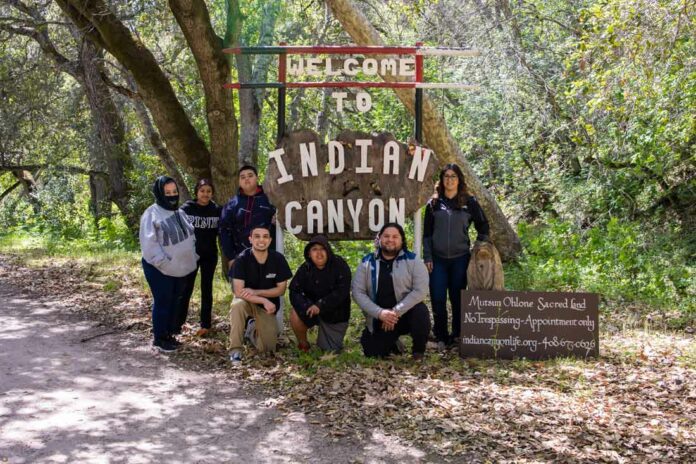As part of a grant from the California Civil Liberties Public Education Program, Youth Alliance recently had the opportunity to participate in a visit to Indian Canyon, a ceremonial site for local indigenous people south of Hollister.
Young people were immersed into this space by Kanyon “Coyote Woman” Sayers-Roods as she greeted the group with a song passed down from her ancestors.
Sayers-Roods is Costanoan Ohlone and Chumash; she is proud of her heritage and her native name and is very active in the native community.
“Indigenous peoples are everywhere,” she said. “There are beautiful rich histories everywhere. Predominantly it is place-based knowledge. That place-based knowledge informs us. Place-based knowledge of our relationship to the environment and our ancestors. Indian Canyon serves as a safe haven for indigenous peoples everywhere and it is one step that we can reconnect to this land.”
Sam Bass, one of the Youth Alliance organizers who participated with youth during the visit to Indian Canyon said, “It was unlike any connection I’d ever felt before. There was a moment of stillness where we all felt unified as we heard Kanyon’s song.”
The opportunity to take youth out into the community and visit places like Indian Canyon was one of the culminating events that Youth Alliance was able to get back to after the pandemic hit.
“Providing our young leaders these opportunities allows them to understand how interconnected we all are and how we should learn from one another in order to move forward collectively,” said Rene Casas, the project coordinator and current Director of Policy at Youth Alliance.
The project seeks to have youth at the forefront of civil liberties conversations and have them engage with local residents, organizations and leaders on various topics. The first topic covered by the project was the Japanese internment on the Central Coast and its civil liberties impact. The project also included intergenerational conversations and historical research about the school-to-prison pipeline, immigration, and native communities on how they have been directly impacted by civil injustices.
“By bringing them into this space, we create an opportunity for young people to have a deeper role in engaging in conversations with elders and communities that have been directly impacted by civil injustices. The oral history of our Central Coast histories is a way for our youth to understand and connect local history with the current struggles for civil rights,” said Diane Ortiz, CEO of Youth Alliance.
Riana Gutierrez, a Youth Engagement Advocate with Youth Alliance who participated in the visit, spoke about what this visit meant to the youth group.
“Being a youth advocate assists our youth in developing their skills in education, social justice and health. We want them to advocate for positive change in their world,” Gutierrez said. “Providing them an opportunity to visit Indian Canyon for the first time and to learn about the history is instrumental in getting them to engage in civil liberties. This makes them realize how much they mean to their community and how they are the future leaders of tomorrow.”
Ortiz, a strong supporter of civil liberties education, said, “Through this Civil Liberties grant, Youth Alliance is able to promote understanding, compassion and intergenerational healing by engaging community youth. By visiting important historical sites like Indian Canyon and sitting in conversation with elders like Mas Hashimoto who lived through the Japanese internment, we hope to connect the past to the present fight for justice. We know there is much work to be done and investing in our youth’s capacity to lead this work is what YA is all about.”
Indian Canyon is the only federally recognized “Indian country” between Sonoma and Santa Barbara. During the 18th and 19th centuries, Indian Canyon served as a safe haven for the local indigenous peoples who were being abducted/recruited/bribed/transported to the missions with the Spaniards. The local Ohlone peoples knew the terrain and were able to traverse the territory into the secluded valley of Indian Canyon.
Since then Indian Canyon has remained a safe haven. Currently, Ann-Marie Sayers and her daughter have opened up the canyon for all Indigenous peoples in need of land for ceremony.
For information about Youth Alliance, visit youthall.org.










